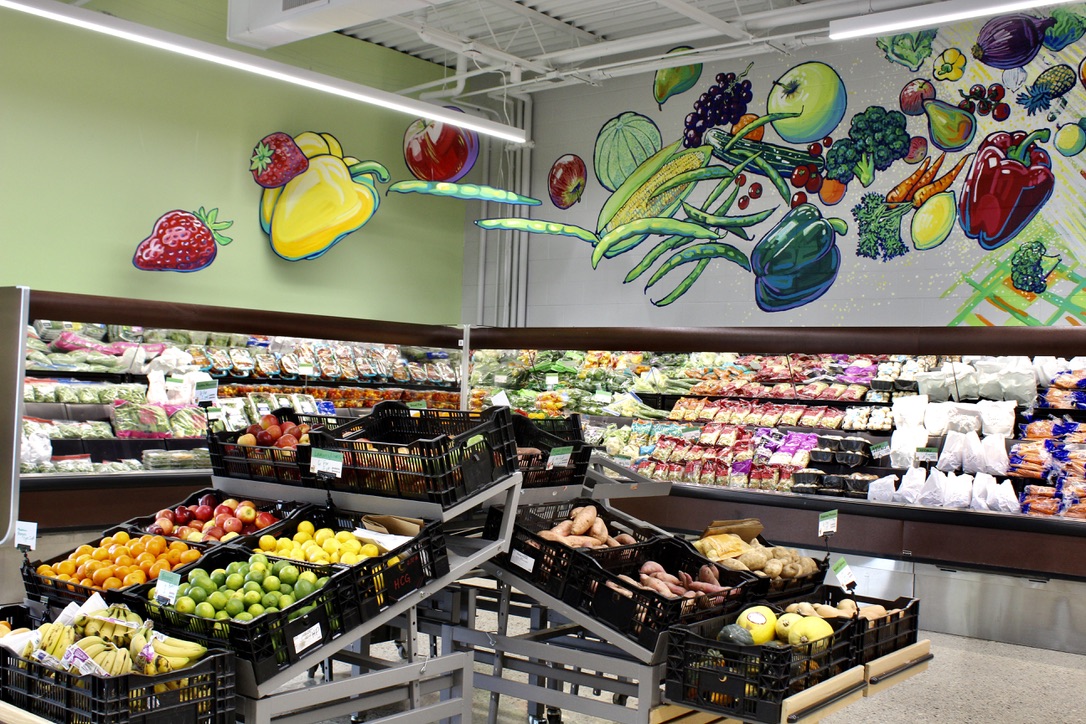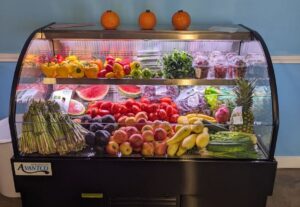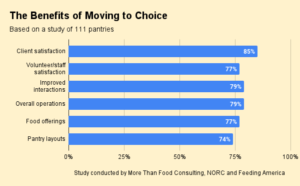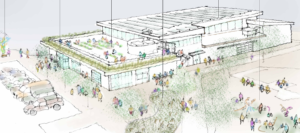Around 2018, Scott Rumpsa started noticing that a majority of people coming to the food pantry and resource center that he runs had steady incomes. But higher rents and living expenses were outpacing their low-wage jobs and Social Security payments, making them regulars at the pantry. It was a contrast from earlier years, when people tended to temporarily come to the pantry before regaining their footing and moving on.
“It was broken-system stuff,” said Rumpsa, who is Executive Director of Community Action House in Holland, Mich.
Rumpsa’s response was to implement a food pantry model that better fit his audience: more focused on the healthy food that people had trouble affording; more respectful of the time demands of working families, and more focused on mimicking a typical grocery-shopping experience.
“This model lets us intentionally target those families that are underserved by the current food pantry system,” Rumpsa said.

The result is Food Club, opened in fall 2021 and combining a number of elements that make it unlike the vast majority of charitable food outlets in this country. One of the big differences is its emphasis on fresh fruit and vegetables. Clients walk away with mounds of them, thanks to a points system that makes it more enticing to select fresh produce than, say, mac and cheese.
Clients gain access to the points through another unique feature: a fee of between $11 and $17 per month, depending on household income, which covers a 30-day membership that includes points that members redeem for about ten days of food, worth as much as $100 to $300 or more, depending on the items selected.
A monthly fee is very out of the ordinary in charitable food, but Rumpsa noted that it’s a minor aspect of the new model. Food Club is more about offering convenience in an uplifting environment along with choice and high-quality food. “It is literally a totally different environment” from the typical food pantry experience, he said. “It’s a feeling of normalized community engagement.”
Rumpsa did not come by the new model by chance. Its first iteration was started seven years ago with the opening of Community Food Club in nearby Grand Rapids, Mich.
The brainchild of half a dozen or so non-profit executives, Community Food Club put forth the idea of a membership fee as a way to bring dignity to the process of accessing food. Guided by the precepts of the book, Toxic Charity, the executives met for three years to plot out their strategy before piloting the food club.

“We developed the idea of a membership fee so people had a stake in the process,” said Kenneth R. Estelle, President and CEO at Feeding America West Michigan, who was part of the committee. The concept of a grocery-store-like environment, with extended hours and lots of choice, to serve paying members was not a model they had encountered anywhere else in the country. “Would anyone be willing to pay a fee? We had no idea,” Estelle said.
In fact, last year an average of 780 households a month paid a $13 membership fee to be part of the Grand Rapids-based Community Food Club, according to AJ Fossel, Executive Director.
Customers are not only members, but they also make up one quarter of the food club’s board and are involved in making decisions about what foods the club should offer. Customer input, for example, led to the creation of Centro Sano (Health Center), a section of the food club that caters to health needs with selections such as gluten-free pasta and lactose-free milk.
“The fee moves people from client to customer,” Fossel said, adding that it’s important enough that the food club has declined offers from funders willing to pick up members’ fees. “People feel good when they pay,” she said.
Membership pays off in a variety of ways. At the Grand Rapids Community Food Club, 98% of members report eating more fruits and vegetables, while 33% report a decrease in lacking adequate food and 30% report an increase in financial security.
The ambition of the Grand Rapids Community Food Club is to spread its version of food access as far and wide as possible. So far, in addition to Rumpsa’s Food Club in Holland, there is one in Luddington, Mich. Using a Replication Kit that is freely available to all, Community Food Club would ultimately like to expand the model nationwide. The kit offers step-by-step guidelines to opening a food club, including branding and messaging to members.
“This model is too good not to share,” Fossel said, adding that the charitable food system is ready for it. “We’ve been doing everything the same way for the last 50 years,” she said. “It’s time to take all we’ve learned and apply it.”

Estelle sees the food-club model growing as smaller, church-based food pantries start to fade away. In fact, the Luddington-based food club, which calls itself a non-profit grocery store, came into being when a handful of local, struggling food pantries came together to create a more sustainable entity, he said.
The closing of small food pantries is a national trend, Estelle added, noting that the number of agency partners his food bank serves has declined from 1,400 in 2011 to about 800 currently. Given the trend, he anticipates “fairly strong replication” of the food club model over the next ten years, he said.
Despite the growth of food clubs, traditional food assistance will not go away. “There will always be room for emergency food assistance as part of a wider system,” said Rumpsa of Community Action House. “But I am a big believer that a more welcoming, efficient and healthy-food-focused form of chronic food assistance is a big wave of the future.”
His still-new food club, which came into being last year after 90% of food pantry guests participating in focus groups said yes to it, is continually attracting new members. “We’re expecting about five times our standard operating service level by the time we’re done with our first year of service,” Rumpsa said.
Imposing a fee does not make a food club less expensive to run than a pantry. Estelle noted that funds from member fees probably amount to about 20% of the total needed, making fundraising a necessity. Rumpsa estimated that running the food club is about twice as expensive as running the former pantry, given the mandates to purchase healthy food, maintain an attractive environment and operate for extended hours. However, by serving more guests through the food club, the cost per healthy meal on the family table is expected to be significantly less.
The chronic stress people are experiencing as incomes stagnate against rising expenses points to the need for a more sustainable, dignified approach. “The reality out there is structural and it is changing,” Rumpsa said. – Chris Costanzo
CAPTION ABOVE: The produce section at Community Action House’s Food Club in Holland, Mich.
Like what you’re reading?
Support Food Bank NewsConnect with Us:














